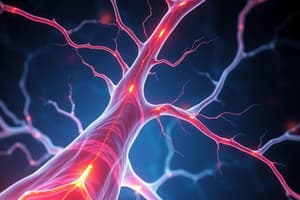Podcast
Questions and Answers
Which statement accurately describes the control of skeletal and cardiac muscles?
Which statement accurately describes the control of skeletal and cardiac muscles?
- Skeletal muscle is involuntary, while cardiac muscle is voluntary.
- Both are controlled involuntarily.
- Skeletal muscle is voluntary, while cardiac muscle is involuntary. (correct)
- Both are primarily controlled by a neurogenic mechanism.
What is the primary function of cardiac muscle?
What is the primary function of cardiac muscle?
- To generate heat during physical activities.
- To maintain posture and stabilize joints.
- To pump blood throughout the cardiovascular system. (correct)
- To facilitate voluntary movements such as running.
Which characteristic differentiates smooth muscle from skeletal and cardiac muscles?
Which characteristic differentiates smooth muscle from skeletal and cardiac muscles?
- Presence of intercalated discs.
- Non-striated appearance due to the absence of sarcomeres. (correct)
- Arrangement of thick and thin filaments into sarcomeres.
- Ability to generate rapid voluntary contractions.
How does the contraction mechanism in smooth muscle operate?
How does the contraction mechanism in smooth muscle operate?
What anatomical feature is absent in skeletal muscles that is present in cardiac muscles?
What anatomical feature is absent in skeletal muscles that is present in cardiac muscles?
Which statement best captures the difference in cell types between skeletal and cardiac muscle?
Which statement best captures the difference in cell types between skeletal and cardiac muscle?
Which of the following statements about muscle contraction is true?
Which of the following statements about muscle contraction is true?
Which feature is common to both skeletal and cardiac muscles?
Which feature is common to both skeletal and cardiac muscles?
What is the significance of elasticity in smooth muscle?
What is the significance of elasticity in smooth muscle?
In terms of cell shape, what distinguishes skeletal muscle from cardiac muscle?
In terms of cell shape, what distinguishes skeletal muscle from cardiac muscle?
Flashcards are hidden until you start studying
Study Notes
Communication and Body Functions
- Involves verbal and facial communication.
- Produces body heat through thermogenesis.
- Assists in chewing and swallowing.
Mechanism of Muscle Contraction
- Neuro muscular transmission transfers information from motor nerves to muscle fibers via the neuromuscular junction (NMJ).
- Resting membrane potential is typically around -70 millivolts (mV).
- An action potential is a temporary shift from negative to positive in a neuron.
Process of Muscle Contraction
- Action potential reaches the nerve terminal, increasing permeability to calcium ions (Ca+).
- Ca+ enters the synaptic cleft, triggering the release of acetylcholine.
- Acetylcholine binds to nicotinic receptors on the post-synaptic membrane, initiating muscle contraction.
- Acetylcholine is destroyed by the enzyme acetylcholinesterase after action potential.
Properties of Cardiac Muscle
- Rhythmicity: Cardiac muscles spontaneously initiate impulses without external stimulation.
- Excitability: Respond to stimuli by generating action potentials.
- Contractility: Converts electrical energy into mechanical contractions.
- Conductivity: Conducts cardiac impulses initiated in the sinoatrial (SA) node.
Contraction of Cardiac Muscle
- Specialized cardiomyocytes known as pacemaker cells generate and conduct impulses for heartbeats.
- Pacemaker cells control heart rate.
- Purkinje fibers provide rapid conduction of electrical signals.
Similarities between Skeletal and Cardiac Muscles
- Both have myofibrils and striations.
- Both contain a capillary network, Actin, and Myosin with A & I bands.
Differences between Skeletal and Cardiac Muscles
- Location: Skeletal muscles are found in bones; cardiac muscles in the heart.
- Nucleus: Skeletal muscles have peripheral nuclei; cardiac muscles have central nuclei.
- Cell Type: Skeletal muscles are multinucleated; cardiac muscles are uninucleated.
- Shape: Skeletal muscles are bundled; cardiac muscles are branched.
- Intercalated Discs: Absent in skeletal muscles; present in cardiac muscles.
- Control: Skeletal muscles are under voluntary control; cardiac muscles are involuntary.
- Contraction: Skeletal contraction is neurogenic; cardiac contraction follows a conductive system.
Function of Cardiac Muscle
- Ensures rapid, involuntary contraction and relaxation for blood circulation.
- Maintains blood pressure within vessels.
Structure and Properties of Smooth Muscle
- Composed of thick and thin filaments not arranged in sarcomeres, leading to a non-striated appearance.
- Homogenous appearance under microscopic examination.
- Rich in actin and myosin, essential for contraction.
Contraction of Smooth Muscle
- Involves sliding of myosin and actin filaments (sliding filament mechanism).
- Elasticity is crucial as smooth muscle tissue needs to stretch frequently.
Studying That Suits You
Use AI to generate personalized quizzes and flashcards to suit your learning preferences.



